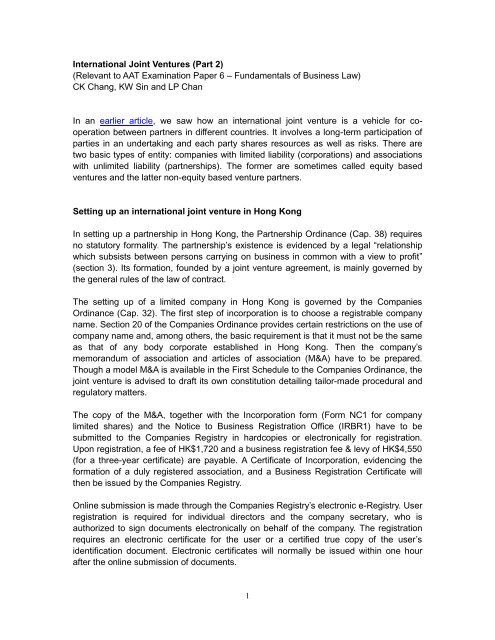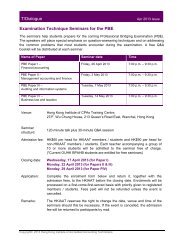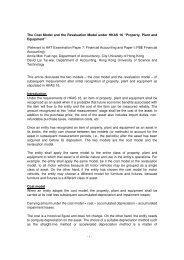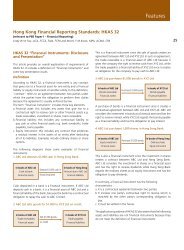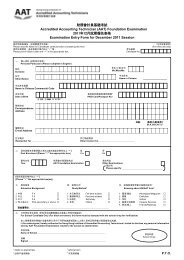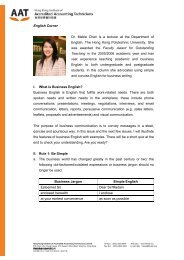International Joint Ventures (2)
International Joint Ventures (2)
International Joint Ventures (2)
You also want an ePaper? Increase the reach of your titles
YUMPU automatically turns print PDFs into web optimized ePapers that Google loves.
<strong>International</strong> <strong>Joint</strong> <strong>Ventures</strong> (Part 2)<br />
(Relevant to AAT Examination Paper 6 – Fundamentals of Business Law)<br />
CK Chang, KW Sin and LP Chan<br />
In an earlier article, we saw how an international joint venture is a vehicle for cooperation<br />
between partners in different countries. It involves a long-term participation of<br />
parties in an undertaking and each party shares resources as well as risks. There are<br />
two basic types of entity: companies with limited liability (corporations) and associations<br />
with unlimited liability (partnerships). The former are sometimes called equity based<br />
ventures and the latter non-equity based venture partners.<br />
Setting up an international joint venture in Hong Kong<br />
In setting up a partnership in Hong Kong, the Partnership Ordinance (Cap. 38) requires<br />
no statutory formality. The partnership’s existence is evidenced by a legal “relationship<br />
which subsists between persons carrying on business in common with a view to profit”<br />
(section 3). Its formation, founded by a joint venture agreement, is mainly governed by<br />
the general rules of the law of contract.<br />
The setting up of a limited company in Hong Kong is governed by the Companies<br />
Ordinance (Cap. 32). The first step of incorporation is to choose a registrable company<br />
name. Section 20 of the Companies Ordinance provides certain restrictions on the use of<br />
company name and, among others, the basic requirement is that it must not be the same<br />
as that of any body corporate established in Hong Kong. Then the company’s<br />
memorandum of association and articles of association (M&A) have to be prepared.<br />
Though a model M&A is available in the First Schedule to the Companies Ordinance, the<br />
joint venture is advised to draft its own constitution detailing tailor-made procedural and<br />
regulatory matters.<br />
The copy of the M&A, together with the Incorporation form (Form NC1 for company<br />
limited shares) and the Notice to Business Registration Office (IRBR1) have to be<br />
submitted to the Companies Registry in hardcopies or electronically for registration.<br />
Upon registration, a fee of HK$1,720 and a business registration fee & levy of HK$4,550<br />
(for a three-year certificate) are payable. A Certificate of Incorporation, evidencing the<br />
formation of a duly registered association, and a Business Registration Certificate will<br />
then be issued by the Companies Registry.<br />
Online submission is made through the Companies Registry’s electronic e-Registry. User<br />
registration is required for individual directors and the company secretary, who is<br />
authorized to sign documents electronically on behalf of the company. The registration<br />
requires an electronic certificate for the user or a certified true copy of the user’s<br />
identification document. Electronic certificates will normally be issued within one hour<br />
after the online submission of documents.<br />
1
For paper submission, the Incorporation form can be obtained from the office or the<br />
website of the Companies Registry. The certificates can usually be issued within four<br />
days of submission.<br />
Some drafting issues in an international joint venture agreement<br />
Since joint ventures can take a number of forms, there are no hard and fast rules for<br />
drafting the agreements. But a good agreement highlights in advance the duties and<br />
obligations of both parties, and this can save many disputes and problems in the future.<br />
Negotiation stages leading to the agreement also vary. There may be an initial stage,<br />
called a preliminary agreement or memorandum of understanding, where the parties<br />
agree certain major issues in principle. This will then be followed by a definitive<br />
agreement which contains the detailed terms of the venture. Taking joint venture<br />
corporations for example, the following basic issues may have to be considered:<br />
1) Purpose and establishment<br />
The agreement may state the actual purpose for which the international joint venture is<br />
formed. This includes the types of business activities and their scope, the duration of the<br />
association and the objectives of the venture. For example, the business activity may be<br />
to market and sell a product in the local party’s home country.<br />
The agreement may also state the legal form to be used. Where valuation and purchase<br />
of shares are involved, the time schedule and the share transfer procedures are also<br />
stated.<br />
2) Operation and management<br />
The board of directors is the governing body of a corporation. The responsibilities and<br />
degree of participation by each joint venture party should be stated. For example, the<br />
agreement should state the number of directors that can be appointed by each of the<br />
joint venture parties, who can appoint the chairman and managing director, etc.<br />
The joint venture parties may or may not be the shareholders of the corporation. But<br />
they must meet regularly to discuss the future of the venture. The agreement could<br />
therefore state how many times the parties should meet each year, how many<br />
representatives there should be from each side and the matters to be discussed such as<br />
business plan and budgets, the progress of the business, or whether any adjustment<br />
needs to be made on the objectives or strategies. How decisions can be reached at such<br />
meetings should also be stated, e.g. by majority vote or whether consent from all the<br />
parties is required for important decisions.<br />
2
3) Capital contribution and allocation of profits<br />
The agreement should also specify both the tangible and intangible capital contribution<br />
of the parties and the policy for sharing profits. For example, it may state that the<br />
corporation shall pay a yearly dividend of not less than a certain percentage of the<br />
distributable profit to the shareholders. There should also be procedures for changes of<br />
control.<br />
In some countries, the law requires that the timing of the joint venture capitalization by<br />
the foreign partner be specified. The agreement should therefore fix the payment<br />
schedule for the capitalization, the currency of the payments and how the payments<br />
should be converted to the host country’s currency.<br />
4) Resolving disputes and financial problems<br />
As the joint venture is founded by parties from different countries with different cultures,<br />
it is very likely that there will be disputes due to conflicting management styles,<br />
misunderstandings, poor communication and differences in expectations.<br />
The joint venture agreement should therefore clearly spell out the mechanisms for<br />
resolving these disputes. Otherwise, management deadlocks may result. Both internal<br />
and external dispute resolution mechanisms should be considered. One common<br />
method is to make use of arbitration if the internal resolution mechanism fails. But issues<br />
like location of arbitration and choice and number of arbitrators have to be considered.<br />
In addition, there may be financial problems or defaults in performance by one of the<br />
parties. The remedies and any interim measures to address such problems need to be<br />
discussed beforehand.<br />
5) Property rights and confidential information<br />
An international joint venture may need to use intellectual property owned by one of the<br />
parties: this may be designs, brands, inventions, database rights or copyright. Therefore<br />
the parties should consider how confidential information and other intellectual property<br />
rights can be shared and protected. Usually the licensor may grant a licence which<br />
specifies what rights and restrictions there are on the joint venture to use the intellectual<br />
property. If necessary, a separate confidentially agreement or non-competition<br />
agreement has to be signed. In addition, issues like proprietary rights and ownership of<br />
any new intellectual property created by the joint venture need to be considered.<br />
3
6) Termination<br />
A joint venture agreement is no more than a contract in which the parties can state how<br />
the agreement is to be terminated. The common example is by serving notice to the<br />
other party. If a joint venture is created for a special project, it may come to an end when<br />
the task is completed. Even when the agreement is terminated, there may be survival<br />
terms like requiring the parties to keep certain information confidential for a number of<br />
years. These provisions can still govern the behaviour of the parties. It is also very<br />
common for one party to buy out the other. In such case, the procedures on transfer of<br />
shares, valuation method and how to choose an independent appraiser should be<br />
agreed beforehand.<br />
7) Miscellaneous provisions<br />
Other issues may be of importance and depend on the countries. The following clauses<br />
may be included in the agreement: applicable law provision, governing language clause,<br />
legal compliance provision (e.g. export and import controls), currency repatriation<br />
provision, force majeure clause, privacy agreement, assignment clause, indemnity<br />
provision for the directors and employees against liability and auditing rights provisions.<br />
Conclusion<br />
Running an international joint venture is not an easy task. It has been reported that<br />
international joint ventures have a high failure rate. One of the causes of failure is often<br />
an inability to overcome cultural differences. Poor partner selection, inadequate planning,<br />
high transaction costs, unequal bargaining, failure to understand the operational need,<br />
lack of management autonomy and poor learning may be other underlying causes for<br />
failure. A successful international joint venture will learn how to operate and co-operate<br />
across national boundaries and has to overcome distrust, tensions and operational<br />
disagreements between the parties at the early stages. But this hard groundwork can<br />
pay off and result in a win-win situation for both parties.<br />
4


